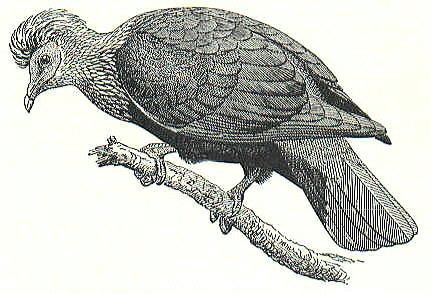
Illustration copyright © 1958 by D.M. Reid-Henry
Mauritius Blue Pigeon
Alectroenas nitidissima
AKA: Pigeon Hollandais
EXTINCT

Illustration copyright © 1958 by D.M. Reid-Henry
Distribution: Endemic to Mauritius Island. Said to be a forest species, the last one being collected from the Savane Forest. Also recorded as living near the river banks. Desjardins, the only eye-witness whose accounts have come down to us, stated it ate fruits & molluscs.
Description: Length 300 mm (Scopoli 1786). A large
pigeon with a head & breast pearly white with many feathers being elongated
with stiffened barbs; had a large fleshy red eye cere. Had a dull greyish blue
belly, dark blue metallic wings & reddish tail feathers.
NOTES: The Mauritius Blue Pigeon, described by Scopoli 1786, survived well into
the 19th century, its extinction probably caused by a combination of
hunting, habitat destruction and predation.
Mauritius Blue Pigeon. (BirdLife International. 2000. Threatened Birds of the World) is known only from three skins and a number of descriptions and paintings, from Mauritius. It was first described by Harmansz in 1602, and persisted for more than two centuries thereafter. Milbert, writing in 1812, noted that he ate many in 1801, and Desjardins reported in 1832 that birds were “still found towards the centre of the island in the middle of those fine forests which by their remoteness, have escaped the devastating axe”. The last specimen was collected in 1826, however, and hunting and habitat loss presumably caused the species' extinction in the 1830s.

Lived
exclusively in Mauritius where it still existed in 1850.
This museum, Port Louis, Mauritius Islands, is fortunate enough to possess one of the three stuffed
specimens in existence, the other two being: one in Paris and one in the Royal Scottish Museum, Edinburg.